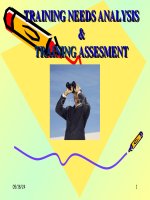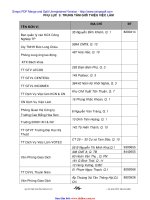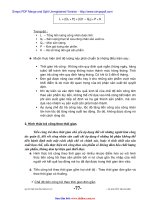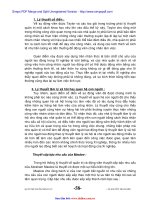Đề cương Quản Trị Nguồn Nhân Lực (có đáp án)
Bạn đang xem bản rút gọn của tài liệu. Xem và tải ngay bản đầy đủ của tài liệu tại đây (53.06 KB, 4 trang )
List and briefly explain each of five steps in the training process.
1.
Steps
Contains
1. Needs analysis
-
Number of trainers
Skill or knowledge required
Date
Training cost (hire trainer, place,…).
2. Instructional design
-
Learning materials (prepare lesson, documents,
homework,…)
Tools, equipment,…
3. Validation
-
Approval from supervisor/top manager (CEO/director)
4. Implementation
-
Choose training method for manager or staff
5. Evaluation & followup
-
Evaluate the result of training program
Follow up trainers
Compare behavior modeling training method and role playing method.
2.
Behavior modeling
Role play
A training technique in which trainees are first shown
good management techniques in a film, are asked to play
roles in a simulated situation, and are then given
feedback and praise by their supervisor.
Creating a realistic situation
in which trainees assume the
roles of persons in that
situation.
3.
Describe 5 steps in recruitment and selection process.
- Step 1: Decide what positions you need to fill, by using employment planning and
-
forcasting.
Step 2: Build a pool of candidates for these jobs by recruiting internal or external
-
candidates.
Step 3: Have candidates complete application forms and undergo a screening
interview.
-
Step 4: Use selection tools like tests, background check, and physical exams to
-
identify suitable candidates.
Step 5: Decide whom to make an offer to, by asking the supervisor and others on the
team to interview the candidates.
4.
Compare unstructured interview and structured interview.
Unstructured interview
-
Definition: The
interviewer pursues
points of interest as they
come up in response to
questions.
Structured interview
-
-
Definition: An interview following a set of
questions.
Advantages:
+ More reliable and valid
+ Help those who may be less comfortable
doing interview to conduct better interview.
+ Standardizing the interview increases
consistency across candidates, enhances job
relatedness, and reduces bias
Disadvantages:
+ Do not always provide the opportunity to
follow up on pointd of interest as they develop.
5.
List and briefly explain 3 main steps of programmed learning method.
- Step 1: Presenting questions, facts, or problems to the learner.
- Step 2: Allowing the person to respond.
- Step 3: Providing feedback on the accuracy of answers.
- Advantages:
+ Reduced training time
+ Self-paced learning
+ Immediate feedback
+ Reduced risk of error for learner
6.
Define paired comparison method.
- Ranking employees by making a chart of all possible pairs of the employees for
each trait and indicating which is the better employee of the pair.
7.
Explain the basic behavior modeling procedure.
- The basic behavior modeling procedure is as follow:
+ Modeling: showing trainees the right (or “model”) way of doing something.
+ Role playing: having trainees practice that way.
+ Social reinforcement: giving feedback on the trainees’ performance.
+ Transfer of learning: encouraging trainees apply their skills on the job.
8.
Define on-site visits.
- Definition: After the campus recruitment exercise, some companies invite good
-
candidates to visit their workplace.
The company may find the following guidelines:
+ Send a warm and friendly invitation letter to candidates.
+ Assign a specific person to meet the application and to act as host.
+ A package describing the applicant's schedule as well as other information
regarding the company.
+ Carefully plan the interviews an adhere to the schedule.
+ Give each candidate undivided attention. Lunch should be hosted by one or more
other recently hired graduates with whom the applicant may feel more at ease.
9.
Identify 3 steps of performance appraisal process.
Steps
10.
Contains
1.
Define the job and its standards
-
Job description
SMART goals
2.
Measure employee’s performance
against these standards
-
Graphic Rating Scale
Paired comparison method
Behavioral Observation Scale
Management by objectives
Alternation ranking method
Critical Incident Method
Forced distribution method
3.
Provide feedback to the employees so
that they can improve their performance
Compare on-the-job training method and apprenticeship training method.
On-the-job (OJT)
-
-
Def: Having a person learn a job by
actually doing the job.
Types:
+ Coaching or understudy
+ Job rolation
+ Observing the supervisor
Advantages:
+ Inexpensive
+ Learn by doing
+ Immediate feedback
Apprenticeship
-
Def: A structured process by which
people become skilled workers
through a combination of classroom
instruction and on-the-job training.
11.
Discuss objectives that make an employee orientation program successful.
- New employee should feel welcome.
- They should understand the company and its policies and procedures.
- They should know what is expected in terms of work and behavior.
12.
Describe Personnel replacement charts.
- Company records showing present performance and promotability of internal
candidates for the most important positions by developing a position replacement
card. It means that you create a card for each position, showing possible
replacement as well as their present performance, promotion potential, and training.









